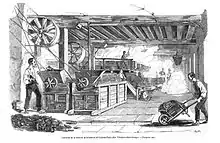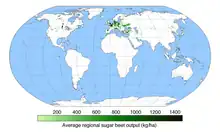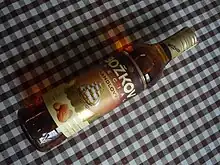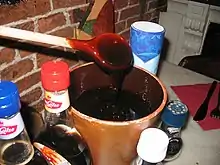Sugar beet
A sugar beet is a plant whose root contains a high concentration of sucrose and which is grown commercially for sugar production. In plant breeding, it is known as the Altissima cultivar group of the common beet (Beta vulgaris).[1] Together with other beet cultivars, such as beetroot and chard, it belongs to the subspecies Beta vulgaris subsp. vulgaris. Its closest wild relative is the sea beet (Beta vulgaris subsp. maritima).[2]
| Sugar beet | |
|---|---|
 Sugar beet, illustration of root, leaf, and flowering patterns | |
| Species | Beta vulgaris |
| Subspecies | Beta vulgaris subsp. vulgaris |
| Cultivar group | Altissima Group |
| Origin | Silesia, mid-18th century |
Sugar beets are grown in climates that are too cold for sugarcane. In 2020, Russia, the United States, Germany, France and Turkey were the world's five largest sugar beet producers.[3] In 2010–2011, Europe, and North America except Arctic territories failed to supply the overall domestic demand for sugar and were all net importers of sugar.[4] The US harvested 1,004,600 acres (406,547 ha) of sugar beets in 2008.[5] In 2009, sugar beets accounted for 20% of the world's sugar production[6] and nearly 30% by 2013.[7] Sugarcane accounts for most of the rest of sugar produced globally.
Description
The sugar beet has a conical, white, fleshy root (a taproot) with a flat crown. The plant consists of the root and a rosette of leaves. Sugar is formed by photosynthesis in the leaves and is then stored in the root.
The root of the beet contains 75% water, about 20%[7] sugar, and 5% pulp.[8] The exact sugar content can vary between 12% and 21%, depending on the cultivar and growing conditions. Sugar is the primary value of sugar beet as a cash crop. The pulp, insoluble in water and mainly composed of cellulose, hemicellulose, lignin, and pectin, is used in animal feed. The byproducts of the sugar beet crop, such as pulp and molasses, add another 10% to the value of the harvest.[6]
Sugar beets grow exclusively in the temperate zone, in contrast to sugarcane, which grows exclusively in the tropical and subtropical zones. The average weight of a sugar beet ranges between 0.5 and 1 kg (1.1 and 2.2 lb). Sugar beet foliage has a rich, brilliant green color and grows to a height of about 35 cm (14 in). The leaves are numerous and broad and grow in a tuft from the crown of the beet, which is usually level with or just above the ground surface.[9]
History of the sugar beet
Discovery of beet sugar


The species beet consists of several cultivar groups. The 16th-century scientist Olivier de Serres discovered a process for preparing sugar syrup from (red) beetroot. He wrote: "The beet-root, when being boiled, yields a juice similar to syrup of sugar, which is beautiful to look at on account of its vermilion color"[10] (1575).[11] Because crystallized cane sugar was already available and had a better taste, this process did not become popular.
Modern sugar beets date to the mid-18th century Silesia where Frederick the Great, king of Prussia, subsidized experiments to develop processes for sugar extraction.[12][13] In 1747, Andreas Sigismund Marggraf, professor of physics in the Academy of Science of Berlin, isolated sugar from beetroots and found them at concentrations of 1.3–1.6%.[14] He also demonstrated that the sugar that could be extracted from beets was identical to that produced from cane.[13] He found the best of these vegetable sources for sugar was the white beet.[15] Despite Marggraf's success in isolating sugar from beets, it did not lead to commercial sugar production.
Development of the Sugar beet
Marggraf's student and successor Franz Karl Achard began plant breeding sugar beet in Kaulsdorf near Berlin in 1786.[16] Achard started his plant breeding by evaluating 23 varieties of beet for sugar content.[17] In the end he selected a local strain from Halberstadt in modern-day Saxony-Anhalt, Germany. Moritz Baron von Koppy and his son further selected white, conical tubers from this strain.[14] The selection was named weiße schlesische Zuckerrübe, meaning white Silesian sugar beet.[16] In about 1800, this cultivar boasted about 5–6% sucrose by (dry) weight.[18] It would go on to be the progenitor of all modern sugar beets.[16] Of course, the plant breeding process has continued since then, leading to a sucrose content of around 18% in modern varieties.[7]
History of the beet sugar industry
Franz Karl Achard opened the world's first beet sugar factory in 1801, at Kunern, Silesia (now Konary, Poland).[9] The idea to produce sugar from beet was soon introduced to France, whence the European sugar beet industry rapidly expanded. By 1840, about 5% of the world's sugar was derived from sugar beets, and by 1880, this number had risen more than tenfold to over 50%.[12] In North America, the first commercial production started in 1879 at a farm in Alvarado, California.[13][14] The sugar beet was introduced to Chile by German settlers around 1850.[14]
Culture


.jpg.webp)
The sugar beet, like sugarcane, needs a particular soil and a proper climate for its successful cultivation. The most important requirements are that the soil must contain a large supply of nutrients, be rich in humus, and be able to contain a great deal of moisture. A certain amount of alkali is not necessarily detrimental, as sugar beets are not especially susceptible to injury by some alkali. The ground should be fairly level and well-drained, especially where irrigation is practiced.[9]
Generous crops can be grown in both sandy soil and heavy loams, but the ideal soil is a sandy loam, i.e., a mixture of organic matter, clay and sand. A subsoil of gravel, or the presence of hardpan, is not desirable, as cultivation to a depth of from 12 to 15 inches (30.5 to 38.1 cm) is necessary to produce the best results.
Climatic conditions, temperature, sunshine, rainfall and winds have an important bearing upon the success of sugar beet agriculture. A temperature ranging from 15 to 21 °C (59.0 to 69.8 °F) during the growing months is most favorable. In the absence of adequate irrigation, 460 mm (18.1 inches) of rainfall are necessary to raise an average crop. High winds are harmful, as they generally crust the land and prevent the young beets from coming through the ground. The best results are obtained along the coast of southern California, where warm, sunny days succeeded by cool, foggy nights seem to meet sugar beet's favored growth conditions. Sunshine of long duration but not of great intensity is the most important factor in the successful cultivation of sugar beets. Near the equator, the shorter days and the greater heat of the sun sharply reduce the sugar content in the beet.[9]
In high elevation regions such as those of Idaho, Colorado and Utah, where the temperature is high during the daytime, but where the nights are cool, the quality of the sugar beet is excellent. In Michigan, the long summer days from the relatively high latitude (the Lower Peninsula, where production is concentrated, lies between the 41st and 46th parallels North) and the influence of the Great Lakes result in satisfactory climatic conditions for sugar beet culture. Sebewaing, Michigan, lies in the Thumb region of Michigan; both the region and state are major sugar beet producers. Sebewaing is home to one of four Michigan Sugar Company factories. The town sponsors an annual Michigan Sugar Festival.[19]
To cultivate beets successfully, the land must be properly prepared. Deep ploughing is the first principle of beet culture. It allows the roots to penetrate the subsoil without much obstruction, thereby preventing the beet from growing out of the ground, besides enabling it to extract considerable nourishment and moisture from the lower soil. If the latter is too hard, the roots will not penetrate it readily and, as a result, the plant will be pushed up and out of the earth during the process of growth. A hard subsoil is impervious to water and prevents proper drainage. It should not be too loose, however, as this allows the water to pass through more freely than is desirable. Ideally, the soil should be deep, fairly fine and easily penetrable by the roots. It should also be capable of retaining moisture and at the same time admit of a free circulation of air and good drainage. Sugar beet crops exhaust the soil rapidly. Crop rotation is recommended and necessary. Normally, beets are grown in the same ground every third year, peas, beans or grain being raised the other two years.[9]
In most temperate climates, beets are planted in the spring and harvested in the autumn. At the northern end of its range, growing seasons as short as 100 days can produce commercially viable sugar beet crops. In warmer climates, such as in California's Imperial Valley, sugar beets are a winter crop, planted in the autumn and harvested in the spring. In recent years, Syngenta has developed the so-called tropical sugar beet. It allows the plant to grow in tropical and subtropical regions. Beets are planted from a small seed; 1 kg (2.2 lb) of beet seed comprises 100,000 seeds and will plant over one hectare (2.5 acres) of ground (one pound or 0.45 kilograms will plant about one acre or 0.40 hectares.
Until the latter half of the 20th century, sugar beet production was highly labor-intensive, as weed control was managed by densely planting the crop, which then had to be manually thinned two or three times with a hoe during the growing season. Harvesting also required many workers. Although the roots could be lifted by a plough-like device which could be pulled by a horse team, the rest of the preparation was by hand. One laborer grabbed the beets by their leaves, knocked them together to shake free loose soil, and then laid them in a row, root to one side, greens to the other. A second worker equipped with a beet hook (a short-handled tool between a billhook and a sickle) followed behind, and would lift the beet and swiftly chop the crown and leaves from the root with a single action. Working this way, he would leave a row of beets that could be forked into the back of a cart.
Today, mechanical sowing, herbicide application for weed control, and mechanical harvesting have displaced this reliance on manual farm work. A root beater uses a series of blades to chop the leaf and crown (which is high in nonsugar impurities) from the root. The beet harvester lifts the root, and removes excess soil from the root in a single pass over the field. A modern harvester is typically able to cover six rows at the same time. The beets are dumped into trucks as the harvester rolls down the field, and then delivered to the factory. The conveyor then removes more soil.
If the beets are to be left for later delivery, they are formed into clamps. Straw bales are used to shield the beets from the weather. Provided the clamp is well built with the right amount of ventilation, the beets do not significantly deteriorate. Beets that freeze and then defrost, produce complex carbohydrates that cause severe production problems in the factory. In the UK, loads may be hand examined at the factory gate before being accepted.
In the US, the fall harvest begins with the first hard frost, which arrests photosynthesis and the further growth of the root. Depending on the local climate, it may be carried out over the course of a few weeks or be prolonged throughout the winter months. The harvest and processing of the beet is referred to as "the campaign", reflecting the organization required to deliver the crop at a steady rate to processing factories that run 24 hours a day for the duration of the harvest and processing (for the UK, the campaign lasts about five months). In the Netherlands, this period is known as de bietencampagne, a time to be careful when driving on local roads in the area while the beets are being grown, because the naturally high clay content of the soil tends to cause slippery roads when soil falls from the trailers during transport.
Production statistics
| Rank | Country | Production (million tonnes) |
|---|---|---|
| 1 | 33.9 | |
| 2 | 30.5 | |
| 3 | 28.6 | |
| 4 | 26.2 | |
| 5 | 23.0 | |
| 6 | 14.2 | |
| 7 | 13.0 | |
| 8 | 11.6 | |
| 9 | 9.2 | |
| 10 | 6.7 | |
| Total | World | 252.9 |

The world harvested 252,968,843 metric tons (249,000,000 long tons; 278,900,000 short tons) of sugar beets in 2020. The world's largest producer was Russia, with a 33,915,086 metric tons (33,400,000 long tons; 37,400,000 short tons) harvest.[3] The average yield of sugar beet crops worldwide was 58.2 tonnes per hectare.
The most productive sugar beet farms in the world, in 2010, were in Chile, with a nationwide average yield of 87.3 tonnes per hectare.[20]
Imperial Valley (California) farmers have achieved yields of about 160 tonnes per hectare and over 26 tonnes sugar per hectare. Imperial Valley farms benefit from high intensities of incident sunlight and intensive use of irrigation and fertilizers.[21][22]
From sugar beet to white sugar

Most sugar beet are used to create white sugar. This is done in a beet sugar factory, often abbreviated to sugar factory. Nowadays these most of the time also act as a sugar refinery, but historically the beet sugar factory produced raw sugar and the sugar refinery refined raw sugar to create white sugar.
Sugar factory
In the 1960s, beet sugar processing was described as consisting of these steps.[23]
- Harvesting and storage in a way that preserves the beet while they wait to be processed
- Washing and scrubbing to remove soil and debris
- Slicing the beet in small pieces called cossettes or chips
- Removing the sugar from the beet in an osmosis process, resulting in raw juice and beet pulp.[23]
Nowadays, most sugar factories then refine the raw juice themselves, without moving it to a sugar refinery. The beet pulp is processed on site to become cattle fodder.
Sugar refinery
The next steps to produce white sugar are not specific for producing sugar from sugar beet. They also apply to producing white sugar from sugar cane. As such, they belong to the sugar refining process, not to the beet sugar production process per se.
- Purification, the raw juice undergoes a chemical process to remove impurities and create thin juice.[24]
- Evaporation, the thin juice is concentrated by evaporation to make a "thick juice", roughly 60% sucrose by weight.
- Crystallization, by boiling under reduced pressure the sugar liquor is turned into crystals and remaining liquor.[25]
- Centrifugation, in a centrifuge the white sugar crystals are separated from the remaining sugar liquor.[26]
- The remaining liquor is then boiled and centrifuged, producing a lower grade of crystallised sugar (which is redissolved to feed the white sugar pans) and molasses.[26]
- Further sugar can be recovered from the molasses eg by the Steffen Process.
Ethanol and alcohol
From molasses

There are two obvious methods to produce alcohol (ethanol) from sugar beet. The first method produces alcohol as a byproduct of manufacturing sugar. It is about fermenting the sugar beet molasses that are left after (the second) centrifugation.[27] This strongly resembles the manufacture of rum from sugar cane molasses. In a number of countries, notably the Czech Republic and Slovakia, this analogy led to making a rum-like distilled spirit called Tuzemak.[28] On the Åland Islands, a similar drink is made under the brand name Kobba Libre.
From sugar beet
The second method to produce alcohol from sugar beet is to ferment the sugar beet themselves. I.e. without attempting to produce sugar. The idea to distill sugar from the beet came up soon after the first beet sugar factory was established.[27] In 1852-1854 Champonnois devised a good system to distill alcohol from sugar beet.[29] Within a few years a large sugar distilling industry was created in France.[27] The current process to produce alcohol by fermenting and distilling sugar beet consists of these steps:[30]
- Adding Starch milk
- Liquefaction and Saccharification
- Fermentation in fermentation vats
- Distillation
- Dehydration, this results in Bioethanol
- Rectification
- Refining, the end result is a highly pure alcohol
Large sugar beet distilleries remain limited to Europe. In 2023 Tereos had 8 beet sugar distilleries, located in France, Czechia and Romania.[31]
In many European countries rectified spirit from sugar beet is used to make Liquor, e.g. vodka, Gin etc..
Other uses
Sugary syrup

An unrefined sugary syrup can be produced directly from sugar beet. This thick, dark syrup is produced by cooking shredded sugar beet for several hours, then pressing the resulting mash and concentrating the juice produced until it has a consistency similar to that of honey. No other ingredients are used.
In Germany, particularly the Rhineland area, and in the Netherlands, this sugar beet syrup (called Zuckerrüben-Sirup or Zapp in German, or Suikerstroop in Dutch) is used as a spread for sandwiches, as well as for sweetening sauces, cakes and desserts. Dutch people generally top their pancakes with stroop.
Suikerstroop made according to the Dutch tradition is a Traditional Speciality Guaranteed under EU and UK law.[32] Commercially, if the syrup has a dextrose equivalency (DE) above 30, the product has to be hydrolyzed and converted to a high-fructose syrup, much like high-fructose corn syrup, or isoglucose syrup in the EU.
Uridine
Uridine can be isolated from sugar beet.
Alternative fuel
BP and Associated British Foods plan to use agricultural surpluses of sugar beet to produce biobutanol in East Anglia in the United Kingdom.
The feedstock-to-yield ratio for sugarbeet is 56:9. Therefore, it takes 6.22 kg of sugar beet to produce 1 kg of ethanol (approximately 1.27 L at room temperature). In 2006 it was found that producing ethanol from sugar beet or cane became profitable when market prices for ethanol were close to $4 per gallon.[33]
Cattle feed
In New Zealand, sugar beet is widely grown and harvested as feed for dairy cattle. It is regarded as superior to fodder beet, because it has a lower water content (resulting in better storage properties). Both the beet bulb and the leaves (with 25% protein) are fed to cattle. Although long considered toxic to cattle, harvested beet bulbs can be fed to cattle if they are appropriately transitioned to their new diet. Dairy cattle in New Zealand can thrive on just pasture and beets, without silage or other supplementary feed. The crop is also now grown in some parts of Australia as cattle feed.[34][35]
Monosodium glutamate
Molasses can serve to produce monosodium glutamate (MSG).
Agriculture

Sugar beets are an important part of a crop rotation cycle.
Sugar beet plants are susceptible to Rhizomania ("root madness"), which turns the bulbous tap root into many small roots, making the crop economically unprocessable. Strict controls are enforced in European countries to prevent the spread, but it is already present in some areas. It is also susceptible to both the beet leaf curl virus, which causes crinkling and stunting of the leaves and beet yellows virus.
Continual research looks for varieties with resistance, as well as increased sugar yield. Sugar beet breeding research in the United States is most prominently conducted at various USDA Agricultural Research Stations, including one in Fort Collins, Colorado, headed by Linda Hanson and Leonard Panella; one in Fargo, North Dakota, headed by John Wieland; and one at Michigan State University in East Lansing, Michigan, headed by Rachel Naegele.
Other economically important members of the subfamily Chenopodioideae:
- Beetroot
- Chard
- Mangelwurzel or fodder beet
Genetic modification
In the United States, genetically modified sugar beets, engineered for resistance to glyphosate, a herbicide marketed as Roundup, were developed by Monsanto as a genetically modified crop. In 2005, the US Department of Agriculture-Animal and Plant Health Inspection Service (USDA-APHIS) deregulated glyphosate-resistant sugar beets after it conducted an environmental assessment and determined glyphosate-resistant sugar beets were highly unlikely to become a plant pest.[36][37] Sugar from glyphosate-resistant sugar beets has been approved for human and animal consumption in multiple countries, but commercial production of biotech beets has been approved only in the United States and Canada. Studies have concluded the sugar from glyphosate-resistant sugar beets has the same nutritional value as sugar from conventional sugar beets.[38] After deregulation in 2005, glyphosate-resistant sugar beets were extensively adopted in the United States. About 95% of sugar beet acres in the US were planted with glyphosate-resistant seed in 2011.[39]
Weeds may be chemically controlled using glyphosate without harming the crop. After planting sugar beet seed, weeds emerge in fields and growers apply glyphosate to control them. Glyphosate is commonly used in field crops because it controls a broad spectrum of weed species[40] and has a low toxicity.[41] A study from the UK[42] suggests yields of genetically modified beet were greater than conventional, while another from the North Dakota State University extension service found lower yields.[43] The introduction of glyphosate-resistant sugar beets may contribute to the growing number of glyphosate-resistant weeds, so Monsanto has developed a program to encourage growers to use different herbicide modes of action to control their weeds.[44]
In 2008, the Center for Food Safety, the Sierra Club, the Organic Seed Alliance and High Mowing Seeds filed a lawsuit against USDA-APHIS regarding their decision to deregulate glyphosate-resistant sugar beets in 2005. The organizations expressed concerns regarding glyphosate-resistant sugar beets' ability to potentially cross-pollinate with conventional sugar beets.[45] U.S. District Judge Jeffrey S. White, US District Court for the Northern District of California, revoked the deregulation of glyphosate-resistant sugar beets and declared it unlawful for growers to plant glyphosate-resistant sugar beets in the spring of 2011.[45][46] Believing a sugar shortage would occur USDA-APHIS developed three options in the environmental assessment to address the concerns of environmentalists.[47] In 2011, a federal appeals court for the Northern district of California in San Francisco overturned the ruling.[38] In July 2012, after completing an environmental impact assessment and a plant pest risk assessment the USDA deregulated Monsanto's Roundup Ready sugar beets.[48]
Genome and genetics
The sugar beet genome shares a triplication event somewhere super-Caryophyllales and at or sub-Eudicots. It has been sequenced and two reference genome sequences have already been generated.[7] The genome size of the sugar beet is approximately 731 (714–758)[7] Megabases, and sugar beet DNA is packaged in 18 metacentric chromosomes (2n=2x=18).[49] All sugar beet centromeres are made up of a single satellite DNA family[50] and centromere-specific LTR retrotransposons.[51] More than 60% of sugar beet's DNA is repetitive, mostly distributed in a dispersed way along the chromosomes.[52][53][54][55]
Crop wild beet populations (B. vulgaris ssp. maritima) have been sequenced as well, allowing for identification of the resistance gene Rz2 in the wild progenitor.[56] Rz2 confers resistance to rhizomania, commonly known as the sugar beet root madness disease.
Breeding
Sugar beets have been bred for increased sugar content, from 8% to 18% in the 200 years up to 2013, resistance to viral and fungal diseases, increased taproot size, monogermy, and less bolting. Breeding has been eased by discovery of a cytoplasmic male sterility line – this has especially been useful in yield breeding.[7]
References
- "Sorting Beta names". Multilingual Multiscript Plant Name Database. 4 May 2013. Archived from the original on 4 May 2013.
- Beta Maritima: The Origin of Beets. Springer. 2012. ISBN 978-1-4614-0841-3.
The volume will be completely devoted to the sea beet, that is, the ancestor of all the cultivated beets. The wild plant, growing mainly on the shore of the Mediterranean Sea, remains very important as source of useful traits for beet breeding.
- "Crops and livestock products". Food and Agriculture Organization.
- "Sugar:World Markets and Trade" (PDF). United States Department of Agriculture: FAS Information. 2011.
- "NASS – Statistics by Subject – Crops & Plants – Field Crops – Sugarbeets". United States Department of Agriculture. 2 October 2006. Archived from the original on 3 October 2006.
- "Agribusiness Handbook: Sugar beet white sugar" (PDF). Food and Agriculture Organization, United Nations. 2009.
- Dohm, Juliane C.; Minoche, André E.; Holtgräwe, Daniela; et al. (18 December 2013). "The genome of the recently domesticated crop plant sugar beet (Beta vulgaris)". Nature. Nature Portfolio. 505 (7484): 546–549. Bibcode:2014Natur.505..546D. doi:10.1038/nature12817. ISSN 0028-0836. PMID 24352233.
- "Agribusiness Handbooks, vol. 4: Sugar Beets / White Sugar" (PDF). 1999. Archived from the original (PDF) on 6 October 2014.
- George Rolph (1873). Something about sugar: its history, growth, manufacture and distribution. San Francisco, J. J. Newbegin.
- Jules Hélot (1912). Histoire Centennale du Sucre de Betterave. OCLC 11941819.
{{cite book}}:|work=ignored (help) - "L'histoire du sucre | Klorane Botanical Foundation". www.kloranebotanical.foundation (in French). Retrieved 2023-02-08.
- Hill, G.; Langer, R. H. M. (1991). Agricultural plants. Cambridge, UK: Cambridge University Press. pp. 197–199. ISBN 978-0-521-40563-8.
- Sugarbeet Archived 20 January 2009 at the Wayback Machine from a University of California, Davis website
- Hanelt, Peter; Büttner, R.; Mansfeld, Rudolf; Kilian, Ruth (2001). Mansfeld's Encyclopedia of Agricultural and Horticultural Crops. Springer. pp. 235–241. ISBN 978-3-540-41017-1.
- Experiences chimiques faites dans le dessein de tirer un veritable sucre de diverses plantes, qui croissent dans nos contrées (Chemical experiments made with the intention of extracting real sugar from diverse plants that grow in our lands). 1749. pp. 79–90.
{{cite book}}:|work=ignored (help) - Doering, Emil (1896). Die Zuckerrübe und ihr Anbau. Eduard Trewent, Breslau.
- Supplement to the Chronicle of the Beet Sugar Industry. 1897.
{{cite book}}:|work=ignored (help) - Birnbaum, Eduard (1887). Der Zuckerrübenbau: kurzgefasste Anleitung zum Anbau der Zuckerrübe für den praktischen Landwirth. W.G. Korn, Breslau.
- "De-icing Highways and Roads Using Sugar Beet Juice". Yahoo!. Archived from the original on 10 February 2013. Retrieved 2 November 2012.
- "FAOSTAT: Production, Crops, Sugar beet, 2010 data". Food and Agriculture Organization. 2011. Archived from the original on 14 January 2013.
- Limb Re (2008). "THE EFFECTIVE COMMUNICATION OF AGRICULTURAL R&D OUTPUT IN THE UK BEET SUGAR INDUSTRY" (PDF). Proc South African Sugar Technology Association. 81: 107–115.
- "Attention to detail critical in meeting beet yield targets". Farmers Guardian. June 2010.
- "An economic study of the beet sugar industry in Montana" (PDF). Montana State University. 1 March 1969. Retrieved 20 January 2023.
- Koyikkal, Srikumar (8 April 2013). Chemical Process Technology and Simulation. PHI Learning Pvt. Ltd. ISBN 9788120347090.
- Dowse, Peter. "Refining sugar cane". sugarnutritionresource.org. Retrieved 3 January 2023.
- Eric Twitty (August 2003). "Silver Wedge: The Sugar Beet Industry in Fort Collins" (PDF). SWCA Environmental Consultants. Retrieved 9 August 2020.
- Levi, Nathaniel (1870). The Sugar Beet: Its Adaptability for Cultivation in the Colony. George Robertson, Melbourne. p. 18.
- "Czechs and Their Billion Dollar Beets". Tres Bohemes. 2017-02-09. Retrieved 2023-03-17.
- d'Aligny, Henry Ferdinand Quarré (1869). The Manufacture of Beet Sugar and Alcohol, and the Cultivation of Sugar-beet. Government printing office, Washington. pp. 40–59.
- "Alcohol and ethanol". Tereos. Retrieved 19 March 2023.
- "Raw Material, Sugar Beet". Tereos. Retrieved 19 March 2023.
- European Commission 2018.
- Cole Gustafson (2010). "Economics of Sugar Beet and Cane Biofuel — Energy". North Dakota State University. Retrieved 2023-02-08.
- "Grower lauds sugar beet 'wonder fuel'". Stuff. 24 June 2014. Retrieved 25 September 2021.
- Group, Rural News. "Fodder, sugar beets dream feed if grown right". ruralnewsgroup.co.nz. Retrieved 25 September 2021.
- Monsanto. "Roundup Ready Sugarbeets".
- "Roundup Ready® Sugar Beet Case – Timeline". APHIS. 7 September 2010. Archived from the original on 17 October 2010.
- "United States Court of Appeals for the Ninth Circuit. No. 10-17719, D.C. No. 3:10-cv-04038-JSW" (PDF). 25 February 2011. Archived from the original (PDF) on 16 October 2013. Retrieved 28 August 2012.
- "Brief 43-2011. Executive Summary: Global Status of Commercialized Biotech/GM Crops: 2011". ISAAA. Archived from the original on 10 February 2012.
- Michigan Sugar Company. "2010 Growers' Guide for Producing Quality Sugarbeets".
- Stephen O Duke & Stephen B Powles (2008). "Glyphosate: a once-in-a-century herbicide: Mini-review". Pest Management Science Pest Manag Sci 64:319–325.
- May, MJ; et al. (2005). "Management of genetically modified herbicide-tolerant sugar beet for spring and autumn environmental benefit". Proc Biol Sci. 27 (1559): 111–119. doi:10.1098/rspb.2004.2948. PMC 1634958. PMID 15695200.
- Mike Abrams (6 February 2009). "Roundup Ready Crops Prove to be a Hit in the USA". Farmers Weekly. Archived from the original on 24 November 2011.
- "Press Release: Monsanto Outlines New Weed Management Platform Under the Roundup Ready PLUS™ Brand". monsanto. 19 October 2010. Archived from the original on 22 June 2012.
- USDA-APHIS (4 February 2011). "Roundup Ready Sugar Beet Case: Timeline". Archived from the original on 1 July 2013.
- USDA-APHIS (29 January 2009). "Environmental Compliance". Archived from the original on 6 October 2014.
- USDA-APHIS. "USDA Prepares Draft Environmental Assessment on Regulatory Options for Roundup Ready Sugar Beets". Archived from the original on 6 November 2010.
- "Roundup Ready® Sugar Beet News". USDA Animal and Plant Health Inspection Service. 7 August 2012. Archived from the original on 13 October 2010. Retrieved 28 July 2012.
- Paesold, Susanne; Borchardt, Dietrich; Schmidt, Thomas; Dechyeva, Daryna (7 September 2012). "A sugar beet (Beta vulgarisL.) reference FISH karyotype for chromosome and chromosome-arm identification, integration of genetic linkage groups and analysis of major repeat family distribution". The Plant Journal. 72 (4): 600–611. doi:10.1111/j.1365-313x.2012.05102.x. ISSN 0960-7412. PMID 22775355.
- Zakrzewski, Falk; Weber, Beatrice; Schmidt, Thomas (2013), "A Molecular Cytogenetic Analysis of the Structure, Evolution, and Epigenetic Modifications of Major DNA Sequences in Centromeres of Beta Species", Plant Centromere Biology, John Wiley & Sons, Ltd, pp. 39–55, doi:10.1002/9781118525715.ch4, ISBN 9781118525715
- Weber, Beatrice; Heitkam, Tony; Holtgräwe, Daniela; et al. (1 March 2013). "Highly diverse chromoviruses of Beta vulgaris are classified by chromodomains and chromosomal integration". Mobile DNA. 4 (1): 8. doi:10.1186/1759-8753-4-8. ISSN 1759-8753. PMC 3605345. PMID 23448600.
- Weber, Beatrice; Wenke, Torsten; Frömmel, Ulrike; et al. (1 February 2010). "The Ty1-copia families SALIRE and Cotzilla populating the Beta vulgaris genome show remarkable differences in abundance, chromosomal distribution, and age". Chromosome Research. 18 (2): 247–263. doi:10.1007/s10577-009-9104-4. ISSN 1573-6849. PMID 20039119. S2CID 24883110.
- Wollrab, Cora; Heitkam, Tony; Holtgräwe, Daniela; et al. (2012). "Evolutionary reshuffling in the Errantivirus lineage Elbe within the Beta vulgaris genome". The Plant Journal. 72 (4): 636–651. doi:10.1111/j.1365-313X.2012.05107.x. ISSN 1365-313X. PMID 22804913.
- Heitkam, Tony; Schmidt, Thomas (2009). "BNR – a LINE family from Beta vulgaris– contains a RRM domain in open reading frame 1 and defines a L1 sub-clade present in diverse plant genomes". The Plant Journal. 59 (6): 872–882. doi:10.1111/j.1365-313X.2009.03923.x. ISSN 1365-313X. PMID 19473321.
- Schwichtenberg, Katrin; Wenke, Torsten; Zakrzewski, Falk; et al. (2016). "Diversification, evolution and methylation of short interspersed nuclear element families in sugar beet and related Amaranthaceae species". The Plant Journal. 85 (2): 229–244. doi:10.1111/tpj.13103. ISSN 1365-313X. PMID 26676716.
- Capistrano-Gossmann, Gina G.; Ries, D.; Holtgräwe, D.; et al. (6 June 2017). "Crop wild relative populations of Beta vulgaris allow direct mapping of agronomically important genes". Nature Communications. 8: 15708. Bibcode:2017NatCo...815708C. doi:10.1038/ncomms15708. PMC 5467160. PMID 28585529.
External links
- How Beet Sugar is Made
- Guardian (UK) article on how sugar beet can be used for fuel
- Sugar beet culture in the northern Great Plains area hosted by the University of North Texas Government Documents Department
- US court bans GM sugar beet: Cultivation to take place under controlled conditions? Archived 13 December 2010 at the Wayback Machine
- "Sugar From Beets" Popular Science Monthly, March 1935
- "Beet Sugar". JSTOR.
